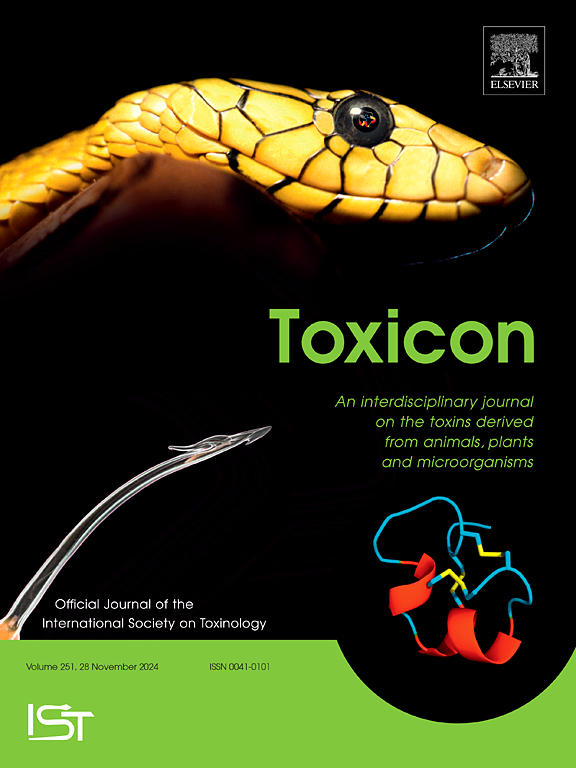Widespread occurrence of botulinum and tetanus neurotoxin genes in ancient DNA
IF 2.6
4区 医学
Q2 PHARMACOLOGY & PHARMACY
引用次数: 0
Abstract
Background
Ancient DNA collected from archaeological specimens not only provides a window into ancient human genetic diversity but also contains a rich mixture of associated microbial DNA including potential pathogens. In recent work, we identified C. tetani and tetanus neurotoxin (TeNT) genes in ancient DNA datasets collected from human archaeological specimens. However, the reasons underlying the occurrence of these toxin genes and the extent to which other toxin genes are present in ancient DNA is unclear.
Methods
Here, we performed a large-scale analysis of 6435 ancient DNA (aDNA) sequencing datasets including human and non-human sources, searching for 49 clostridial neurotoxin types and subtypes, and 3 additional unrelated toxins.
Results
Our search identified a total of 105 ancient DNA datasets (1.6 %) containing significant matches to one or more neurotoxin genes. Consistent with our earlier work, TeNT genes were most common, found in 50 ancient DNA datasets. In addition, we identified sequences encoding diverse botulinum neurotoxins including BoNT/C (40 samples), BoNT/D (6 samples), BoNT/B (4 samples), BoNT/E (1 sample), and the Enterococcus-associated BoNT/En (10 samples). TeNT genes were detected in a broad range of ancient samples including human and animal (horse, wild bear, chimpanzee, gorilla, dog) remains, whereas the largest diversity of toxins was detected in aDNA from Egyptian mummies. Phylogenetic and sequence analysis of the identified matches revealed close identity to modern forms of these toxins. Damage analysis revealed several toxin genes with hallmarks of ancient DNA associated damage, indicative of an ancient origin.
Conclusions
Our work reveals that clostridial neurotoxin genes occur frequently in aDNA samples, including human and animal-associated toxin variants. We conclude that the frequent association of these genes with aDNA likely reflects a strong ecological association of pathogenic clostridia with decaying human and animal remains and possible post-mortem colonization of these samples.
在古代DNA中广泛存在肉毒杆菌和破伤风神经毒素基因。
背景:从考古标本中收集的古代DNA不仅提供了一个了解古代人类遗传多样性的窗口,而且还包含了丰富的相关微生物DNA混合物,包括潜在的病原体。在最近的工作中,我们在从人类考古标本收集的古代DNA数据集中鉴定了破伤风梭菌和破伤风神经毒素(TeNT)基因。然而,这些毒素基因发生的原因以及其他毒素基因在古代DNA中存在的程度尚不清楚。方法:本研究对6435个包括人类和非人类来源的古DNA (aDNA)测序数据集进行了大规模分析,寻找49种梭状芽孢杆菌神经毒素类型和亚型,以及另外3种不相关的毒素。结果:我们的搜索共确定了105个古代DNA数据集(1.6%),其中包含一个或多个神经毒素基因的显著匹配。与我们早期的工作一致,TeNT基因是最常见的,在50个古老的DNA数据集中发现。此外,我们还鉴定了编码多种肉毒杆菌神经毒素的序列,包括BoNT/C(40个样本)、BoNT/D(6个样本)、BoNT/B(4个样本)、BoNT/E(1个样本)和与肠球菌相关的BoNT/En(10个样本)。在包括人类和动物(马、野生熊、黑猩猩、大猩猩、狗)遗骸在内的广泛古代样本中检测到TeNT基因,而在埃及木乃伊的aDNA中检测到的毒素多样性最大。系统发育和序列分析鉴定的匹配显示接近身份的现代形式这些毒素。损伤分析显示,几个毒素基因具有古代DNA相关损伤的特征,表明其起源古老。结论:我们的工作表明梭状芽孢杆菌神经毒素基因在aDNA样本中频繁出现,包括人类和动物相关的毒素变体。我们得出结论,这些基因与aDNA的频繁关联可能反映了致病性梭菌与腐烂的人类和动物遗体以及这些样本可能的死后定植的强烈生态关联。
本文章由计算机程序翻译,如有差异,请以英文原文为准。
求助全文
约1分钟内获得全文
求助全文
来源期刊

Toxicon
医学-毒理学
CiteScore
4.80
自引率
10.70%
发文量
358
审稿时长
68 days
期刊介绍:
Toxicon has an open access mirror Toxicon: X, sharing the same aims and scope, editorial team, submission system and rigorous peer review. An introductory offer Toxicon: X - full waiver of the Open Access fee.
Toxicon''s "aims and scope" are to publish:
-articles containing the results of original research on problems related to toxins derived from animals, plants and microorganisms
-papers on novel findings related to the chemical, pharmacological, toxicological, and immunological properties of natural toxins
-molecular biological studies of toxins and other genes from poisonous and venomous organisms that advance understanding of the role or function of toxins
-clinical observations on poisoning and envenoming where a new therapeutic principle has been proposed or a decidedly superior clinical result has been obtained.
-material on the use of toxins as tools in studying biological processes and material on subjects related to venom and antivenom problems.
-articles on the translational application of toxins, for example as drugs and insecticides
-epidemiological studies on envenoming or poisoning, so long as they highlight a previously unrecognised medical problem or provide insight into the prevention or medical treatment of envenoming or poisoning. Retrospective surveys of hospital records, especially those lacking species identification, will not be considered for publication. Properly designed prospective community-based surveys are strongly encouraged.
-articles describing well-known activities of venoms, such as antibacterial, anticancer, and analgesic activities of arachnid venoms, without any attempt to define the mechanism of action or purify the active component, will not be considered for publication in Toxicon.
-review articles on problems related to toxinology.
To encourage the exchange of ideas, sections of the journal may be devoted to Short Communications, Letters to the Editor and activities of the affiliated societies.
 求助内容:
求助内容: 应助结果提醒方式:
应助结果提醒方式:


